#Port Glasgow
Text

Mother Margaret with her daughter Rosemary. Port Glasgow, Scotland. 2004. From the series 'A8'
Photo: Martin Parr
22 notes
·
View notes
Text
Missing Teen - Ava Malloy
Ava was last seen in the Port Glasgow area at 13:35 hours on Saturday 15th June 2024.
Police are asking for the public’s assistance in tracing Ava Malloy 13 years old.
Ava was last seen in the Port Glasgow area at 13:35 hours on Saturday 15th June 2024.
She is described as 5ft 3in tall, slim build, with long brown hair. When last seen she was wearing a black Nike long sleeve top, black leggings and black trainers.
Anyone with information is asked to contact police on 101…

View On WordPress
0 notes
Text
LOTD: Port Glasgow
~sorry for delay - meant for July 20th, 2023~
(from: http://www.ibiblio.org/lighthouse/sctsw.htm)
Port Glasgow (2)
1919 (station established 1861). Active; focal plane 7 m (23 ft); continuous green light. 7 m (23 ft) round tower with lantern and a narrow gallery. Lighthouse painted in a black and white checkerboard pattern; lantern dome is white. Trabas has a fine photo, Peter Goulding has a page with good photos, Thomas Nugent has an excellent photo, Spencer has a photo, Google has a street view, and Bing has a satellite view. Located on a rocky ledge about 200 m (220 yd) off the Port Glasgow waterfront. Accessible only by boat, but easily seen from the waterfront. Site and tower closed. Operator: Clydeport. ARLHS SCO-311; Admiralty A4476; NGA 4588.

(full photo found here; ©Joy Tubby)
0 notes
Text
The Street Where She Was Born
The Street Where She Was Born
King Street, Port Glasgow, Scotland
Walking up and down King Street in the smirr ((A smirr is a Scottish word for a fine rain drizzle.)), I imagined her birth cry echoing beyond the flat where her lungs first breathed in oxygen. After a long labor, her mother’s painful wails became joyful laughter of her mother at first sight of her beloved Elizabeth.
Or so I imagine. I know so little about…

View On WordPress
#family history#genealogy#grandmother#Great-Grandmother#importante#love#Port Glasgow#roots#Scotland#wisdom of ancestors
0 notes
Text
Port Glasgow blood-smeared car incident
1 note
·
View note
Text
I need a fic where Ghost and Soap are on the run but like, framed and on the run.
They're on an assignment, just the two of them, to co-lead a team for the prevention of assassination for some big-name politician (dunno, I like to think this would happen either in usa or in the uk...) and it's all done and they're about to pack their shit and go back to base when Soap gets an encrypted call from Price to tell him that a video of Ghost killing the same big-name politician is on the telly
It's not Ghost, obviously, but it's someone of Ghost's posture, in Ghost's gear and Ghost's mask.
Also obviously, Soap doesn't believe it.
They get surrounded pretty fast by the local SWAT-like team and Soap makes Ghost use him as a hostage so they can escape with a minimal amount of maiming -- Soap is pretty sure Ghost could escape on his own, but it'd be a bloody mess that would follow him after he was proven to be framed.
Of course, Ghost tries to get Soap to leave once they're out of the danger zone. He does not.
Cue Ghost and Soap on the run while Price, Gaz and Lasewell try to find out who is framing him.
Simon's existence was erased so much that there are no pictures of him anywhere so instead, his APB has a sketch and a description. Problem is, the scars on his face were included, and way too characteristic to miss them (whether it's the glasgow smile or other scars, dunno, but you get my point). At first, it's really hard to move around because scars/mask + Simon being like 6'4 and built like a tank scream 'notice me'. Simon grows out a beard - it's red-ish blond colour so he ends up dying his hair red too. He absolutely doesn't care but Soap mourns because he's barely started being able to see Simon's face and hair and now it's all changed up.
Soap doesn't have an APB at first, but after a couple of days he is named as complicit (because he's seen helping Ghost run) and his photo is out. He has to shave the mohawk because it's too eye-catching (he's fucking bald and he hates it). He has to rein in his accent because he is described as glasgowian scottish. He can't call his maw so he sends her a random postcard he picked up a few towns ago and sends a short and cryptic message, hoping she believes he's not a terrorist.
Soap also finds out Ghost knows way too many shady people and knows way too easily where to look for even more shady people if he needs something the former people don't have. They steal shit out of necessity, often clothes and food, but sometimes they pickpocket cards and wallets. Some days they sleep in the car, some days they stop at questionable motels or hostels, and some days they don't sleep at all. They have burner phones but don't contact Price at all.
There would be a mandatory 'taking care of each others' wounds' scene (no bandages, please, you rarely use bandages in healthcare nowadays) after a dangerous run-in, a mandatory 'pretend to be a couple to lose the trail' and after that, an awkward 'there was only one bed' scene where things happen for the first time and they have a sloppy handjob or two.
They're probably trying to escape the country but can't do it via air because of the APBs and have to make their way to some shady port and even shadier ferry or cargo ship that won't run their fake passports in the system if they pay well enough.
Ghost is surprising Soap once again with an off-shore bank account and a knowledge of whichever country they're in's language. They move somewhere less crowded but not small enough that two Brits would be weird. Some people refer to Ghost as Soap's husband.
Weeks or months go by.
"What if they can't prove I didn't do it?"
"You faked your death once, love, I think you can do it twice."
240 notes
·
View notes
Text





7th August 1894 saw the first train arrives in Fort William on the newly opened West Highland Line.
The West Highland Line runs from Glasgow to Fort William, the largest town in the West Highlands of Scotland, and onwards to Mallaig, a tiny fishing port and terminal for the ferry to Armadale on the Isle of Skye. Most of the line is a twisting single track railway through fabulous Highland scenery, often miles from the nearest road. There's also a branch to Oban, the ferry terminal for various Scottish islands, dubbed The Gateway to the Isles.
Tiring of the 50-mile trek to the railhead of Kingussie on the Highland Line to Inverness, the citizens of Fort William decided they must have their own railway, and construction started in 1889. It was not an easy railway to build, across remote and difficult regions of the Scottish highlands. Lack of money meant the line featured many steep gradients and sharp curves as more direct alignments would have meant expensive viaducts & cuttings. The first trains linked Glasgow with Fort William in August 1894.
The next step was an extension to the sea, to serve the fishing industry on the west coast. A plan to serve Roshven was blocked by a local landowner, so Mallaig was chosen instead. However, the extension became something of a political football and the Mallaig Extension wasn't opened until 1901.
The separate branch line to Oban wasn't originally part of the Glasgow-Fort William-Mallaig line at all, it had its own route from Glasgow via Callander, opened in 1880 and operated by the rival Caledonian Railway. This passed under the Glasgow-Fort William line just north of Crianlarich, and you can just make out the old track-bed today from the train to Fort William. The line from Glasgow via Callander was closed during the Beeching cuts in the 1960s, and trains between Glasgow and Oban diverted to share the line to Crianlarich with the Fort William trains.
Whilst all journeys on the West Highland Line are enjoyable, the Jewel in the Crown must surely be the Jacobite steam-hauled train from Ft William to Mallaig, it is often sold out and popularity in the journey was helped by the success of the Harry Potter books and films.
44 notes
·
View notes
Text
The Port & the City

Buenos Aires, photo by lasgalletas (Creative Commons CC BY-NC 2.0)
Introduction
City of witches and of asphalt,
port with no exit to the sea!
— La Portuaria, from the port of Buenos Aires
Some cities have a port, and some port cities have a port culture. That's how I call it, anyway. It's a very special thing. It's created by the furious economic activity that concentrates around the coming and going of ships, cargo, and people. A port needs to cater to all of that, the ships and the cargo, the shipowner and the dockworker, the captain and the deckhand, the tourist and the sailor and the fisherman. And that transforms the entire city.
Where a port city meets the sea, there's shipping companies, travel agencies, imports/exports, truck companies, posh hotels, shitty hotels, fancy bars, seedy bars, brothels, strip clubs, theatres, restaurants, casinos, bookshops, tool shops, souvenir shops, fishing supplies, and fresh fish. There's peddlers and businessmen, porters and accountants, all sorts of people, and they all mingle. They have to! The port's there!
Port cities have their own landmarks and geography, with docks, wharfs, piers, depots, gates, shipyards, and people can orient themselves by relation to the water.

New York City, photo by Kari Nousiainen (Creative Commons CC BY-NC 2.0)
Crime
My gold watch and my pocketbook and lady friend were gone
And there was I, Jack all alone, stark naked in the room
— the port of New York City
Port cities attract furious criminal activity. Firstly and obviously, everything that's smuggled will be smuggled through here, from cocaine to counterfeit handbags to guns to oil. (I mean crude/refined oil, though with the prices we've seen lately, olive oil is equally plausible.) Port authorities, customs, shipowners and workers, all can have a hand in the pie, a little finger or both hands shoulder-deep, depending on how high up the ladder they are.
Second, ports are always full of newcomers, sailors and passengers, and all newcomers are potential marks. Con artists, scammers, and grifters of all sorts can ply their trade here. There's also a lot of shilling for more or less legitimate businesses (come buy this, sir! rent a room here, ma'am! oh but you must have a drink there, buddy!), and peddling less then legitimate goods (may I interest you in a fine watch? Rayban glasses, I have Rayban glasses! 100% genuine!). And then there's good old pickpocketing. Although in most cases, pickpockets are not allowed to operate within the port itself: it's bad for everyone else's business, and unlike cops, "everyone else" can actually enforce that.
And third, there's the entertainment sector: the trifecta of night life, sex work, and gambling, all going hand in hand with the sale and consumption of drugs and booze. Expect the port city to be much more entangled in all that than other cities, and the port itself to attract the bulk of it, or the worst of it. Things that are theoretically illegal might be tolerated here, things that are heavily regulated elsehwhere might follow their own rules here, and things that are otherwise unheard of can be found here. What are you into? Step right up but beware: the large print giveth and the small print taketh away.
The upshot of all this is that people in the port's vicinity (not the whole city, though) are more likely to be involved, or at least personally know someone who's involved, in profoundly shady and/or illegal business. And that certainly affects the culture. Breaking the law is more "eh" than "oh my!".
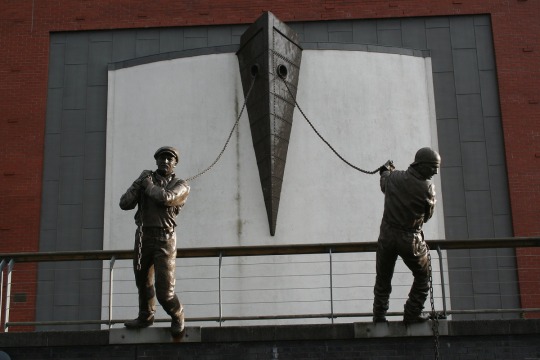
Clydebuilt Museum, photo by Paisley Scotland (Creative Commons CC BY 2.0)
Politics
All my life I've lived beside the waters that they call the Clyde
I build the ships and watch them glide down the Broomielaw, sir
Trudge to work in sleet and rain, labour for another's gain
know yer place and don't complain, that's the rich man's law, sir
— Alistair Hulett, from the shipyards of Glasgow
A port displays furious political activity. Unions are strong here, because labour is not only working, it's working hard, manually, in the same spaces (so they can talk about it!), and facing the same dangers to life and limb. Working on the docks, handling cargo containers, and ship-building and maintenance are very hazardous jobs (scrapping even more so, I'd say dramatically so), and under these conditions, it's easier to spot the enemy. Not automatic though. Port cities are traditionally, but not unconditionally, strongholds of the left.
Today, it's extremely important for the left to take the ports, because if it doesn't the fascists will. The workforce here has significant ethnic diversity, coming both from inland (immigrants and local minorities) and from the sea (sailors who go around the world sometimes end up working in random ports). So basically, this either goes "proletarians of the world unite" or "foreigners are stealing our jobs", no middle ground.
By the way, if all your knowledge about port unions comes from The Wire, or worse (for our older readers) from On the Waterfront, please be aware that these are slanted depictions, and you don't actually know anything. [They're not equally slanted, The Wire is nowhere near the other one's level of shameless propaganda, nor so completely divorced from reality. I mean yes, unions can be involved in shady business; so can literally everyone else in the port. But On the Waterfront, without the slightest exaggeration, is to American organised labour what Birth of a Nation is to Black Americans.]

Valparaíso, photo by [o] Rolando Vejar (Creative Commons CC BY-SA 2.0)
Culture
Amo el amor de los marineros que besan y se van.
Dejan una promesa. No vuelven nunca más.
— Pablo Neruda, from the port of Valparaíso
The port's culture seeps through the rest of the city. This is where sailor lore gets created and spread, and a port by definition loves travel and the ocean. Many non-sailors fall for it hook, line and sinker, and write poems and sing songs and their heart swells at the mere thought of sailing. But their fascination is often rose-tinted, whereas people who make a living from the sea typically have a love/hate relationship with it.
Maiden voyages are important occasions in shipbulding ports. A ship's last voyage, before it goes to scrap, is also memorable. If the ship regularly docks there, it will be the talk of the town, and if it's a passenger ship [this assumes a geography with regular passenger runs], a whole mess of people will be sharing stories and memories, waving it farewell, shouting, applauding, crying a little. It can get very emotional.
There's also a silly sort of localism/professional pride going on, where even the port's accountants, who've never set foot below decks IF they've actually boarded a ship, feel like they're a different species of accountant, inexplicably tougher and saltier than their more, er, inland colleagues. No matter who you are and what you do, it's badge of honour to say you're from and/or work at the port, like you're automatically endowed with tenacity and street smarts. It doesn't make sense, but there you have it.
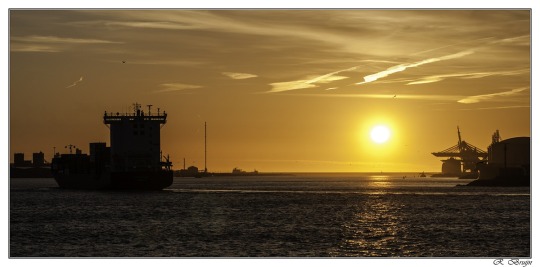
Rotterdam, photo by MaxAmy Photography (Creative Commons CC BY-ND 2.0)
Desire
In the port of Amsterdam there's a sailor who dies
Full of beer, full of cries, in a drunken town fight
In the port of Amsterdam there's a sailor who's born
On a hot muggy morn by the dawn's early light
— Jacques Brel (in David Bowie's adaptation), from the port of Amsterdam
A port is filthy, grubby, and hopelessly romantic. If it faces somewhat west, it's on fire every sunset. Silhouettes of gigantic cranes are framed by red clouds like alien tripods. The sun sinks into the ocean, and tell me, in the whole wide earth, is there a sweeter sight? Ships approach like sea beasts, and dock in their usual place like old friends.
A port carries the whiff of grease and petrol, the cool sea breeze, and the incessant sounds of waves and engines and – most of all – people. A port IS people, passing. And tell me, in the whole wide world, is there anything more exciting and heartwrenching than people passing? A port city can fill you with wanderlust and feel like a prison, or a warm welcome, or a devastating farewell.
And if you point a gun to my head and force me to describe a port in a single word, I'll have to say: desire.
Love me, leave me, hold me tight, walk away, forget.
Look at how I broke inside, and how the sea has swelled!
It's pouring out a riot of colours, scents, and lights,
and in the city's gutter it's building paradise.
— Ξύλινα Σπαθιά, from the port of Thessaloniki

Thessaloniki, photo by Arend Kuester (Creative Commons CC BY-NC 2.0)
La Portuaria - Un dia cualquiera (El bar de la calle Rodney) | the port of Buenos Aires
Ξύλινα Σπαθιά - Ρόδες | the port of Thessaloniki
Tom Waits - Step right up
Finbar Furey - New York City girls | the port of New York
The Dubliners - Go to sea no more | the port of Liverpool
Alistair Hulett - The Old Divide and Rule | the shipyards of Glasgow
The Dreadnoughts - Roll Northumbria | the shipyards of Tyne
The Longest Johns - Fire & flame | the port of Halifax
Maria del Mar Bonet - Merhaba | the ports of the Mediterranean
Cesária Évora - Mar de canal | the port of Mindelo
Susana Baca - Los marineros | the port of Valparaíso
Παντελής Θαλασσινός - Άσπρο καΐκι στη Νέα Πέραμο | the little port of Nea Peramos
Jacques Brel - Amsterdam | the port of Amsterdam
Social Waste - Kasbah | the port of Algiers
Πάνος Κατσιμίχας - Ο πιλότος Νάγκελ | the port of Colombo, so far from Lofoten
Ξύλινα Σπαθιά - Φωτιά στο λιμάνι | the port of Thessaloniki
#the city speaks#theory#trs#the ramblin' rover#pirate#booze#booze et al#no tears for the creatures of the night#smuggler#pickpocket#mixtape#prison ballads#ONE of these days I'll learn to be concise I swear#also I ain't translating Naruda to english#the Rogue's school of translation gives exactly zero fucks#but there's a limit#look it up it's called ''Farewell''#also I didn't include a planned section on immigration#because I got too fucking upset to write words
57 notes
·
View notes
Text

Glasgow Road SW, Port Washington, Ohio.
44 notes
·
View notes
Text

Between the 1960s and 1998, Northern Ireland was embroiled in an ethno-nationalist conflict known as The Troubles. While the conflict mostly took part in Northern Ireland, the violence sometimes spilled over to the Republic of Ireland, England and even mainland Europe.
A total of 3,532 people died during these years, and another 47,500+ were injured.
For many, Northern Ireland was a no-go zone throughout The Troubles, but there was one woman who looked past the discord and came to visit: 18-year-old Inga Maria Hauser.
Inga was a student from Munich, Germany. She was known for her intrepid spirit, and had ambitions of one day becoming a singer. Inga was also a keen artist.
In March of 1988, Inga left her home in Munich and went backpacking across England and Scotland. On the 6th of April, 1988, Inga boarded a ferry in Scotland to Larne, Northern Ireland.
During her travels, she kept a diary which she used to document the sights she saw and the people she met.
That morning, she had written in her diary: “Morning has broken in Scotland. Breakfast in Inverness. Nice town. Have to see the Loch Ness monster one day. Going to Glasgow now. Snowy mountains and wild landscape. Scotland is beautiful.”
The ferry docked in Larne at 9:40PM. Inga stepped off the ferry and disappeared into thin air, only to turn up dead two weeks later.....
𝐑𝐞𝐚𝐝 𝐌𝐨𝐫𝐞:
29 notes
·
View notes
Note
I want to know everything you're willing to say about Blair
omg okay, i'll try to be concise. here's their family tree and here's some design notes. the rest is under the cut.
blair (they/she) was born in an apainn/appin, in the scotland highlands on may 13th, 1997. full name: blair marina stewart. they have a gaelic name as well (bhlair maired stiùbhart). their parents are called james and eleanor, and they have an older brother as well; his name is colin and he's four years older than blair.
since an apainn is a very small town, with a super tiny population, she spent a lot of time with her brother around their family property. they'd herd sheep and take care of the other animals, and spend a lot of time at port appin watching the ferry. they were in a band together, with both of them playing the fiddle. blair also plays the piano, is very keen on tap dancing and they know how to knit. besides english, they speak scottish gaelic and they learn scots later on. they're left handed.
their family moved to glasgow in the first half of 2009 so blair could attend secondary school and colin could attend college. getting used to this different environment was very hard for blair and they struggled a lot. blair didn't understand their peers and they often felt alone. she had only two friends: moira stirling and aiden douglass. to make matters worse: colin and blair got involved in a very bad car accident in 2009 when he was driving them around (without authorisation), in slippery road. colin passed away and blair ended up with a broken arm and the scar on their right eye. this torn their family apart and their parents divorced in 2010. blair stayed with her mother, and then later on in 2013 they moved to the u.s. (right before the start of high school story prime).
they were raised roman catholic and their family frequented church. catholic guilt is a theme in blair's character and it's present in every single aspect of their life. from their identity, to their actions, to their choices, to the friends they make, to the words they say. guilt, fear and shame move blair. they stopped attending the church on their 16th birthday.
besides that, blair has issues with self-image and they've had an eating disorder from the time they were 13. being an overachiever, they push themselves too much and they have very unhealthy coping mechanisms. they're still mourning their brother as well, as it was something they felt they never got the chance to. a lot of survivor's guilt. they're riddled with anxiety, which makes them a very neurotic individual. they want to help everyone all the time and they want everyone to feel happy/comfortable/safe/welcome, which it's not something 100% possible to do and they end up getting overwhelmed.
blair is non-binary and bisexual, and while they're out to their friends, they're not out to their family. they don't have a good relationship with their mother. they were close to their father.
regarding high school story: i've mentioned before, but i see the game taking place in 2013 and it's set on blair's third year of high school. their best friends are autumn (of course) and payton, and they're really close to nishan as well. they're a nerd in game. they're in the cheer team and in the math team. they start dating wes sometime after the heist at hearst <- this causes them shame and guilty and everything else due to the... dynamics of their friend group.
i think that's it. there's probably more i can talk about, but i think this paints a good picture of their character. i can answer any questions about them and/or expand further on anything i've shared here!
12 notes
·
View notes
Text
Good News - May 1-7
Like these weekly compilations? Support me on Ko-fi! Also, if you tip me on Ko-fi, at the end of the month I'll send you a link to all of the articles I found but didn't use each week - almost double the content!
1. New study says conservation works, providing hope for biodiversity efforts
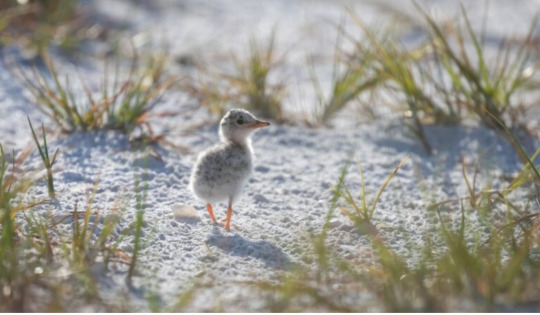
“A new study published in Science reveals that conservation works, with conservation actions improving or slowing the decline of biodiversity in two-thirds of the cases analyzed.”
2. Monk Seal Pup Debuts in Waikīkī on Lei Day
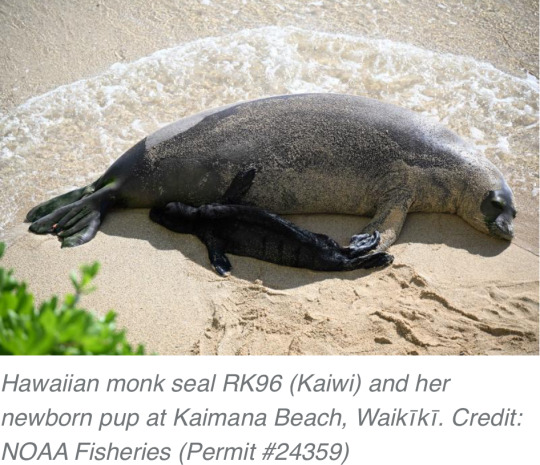
“Endangered Hawaiian monk seal RK96 (Kaiwi) gave birth to her sixth pup on popular Kaimana Beach in Waikīkī, Oʻahu! […] Hawaiian monk seals are one of the most endangered seal species in the world, so each pup represents hope for the species’ recovery.”
3. West Coast Indigenous-led marine conservation area gets global spotlight
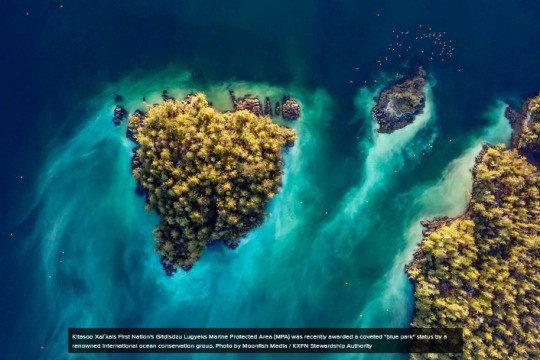
“A coastal First Nation is celebrating global recognition of its marine protected area after recently snagging a “blue park” designation that highlights exemplary ocean conservation efforts around the world. […] Kitasu Bay supports one of the last abundant herring spawns along the central coast, vital to the nation’s communal herring roe on kelp (ROK) fishery - which harvests the protein-rich eggs but leaves the fish alive to flourish and spawn again.”
4. The number of fish on US overfishing list reaches an all-time low. Mackerel and snapper recover
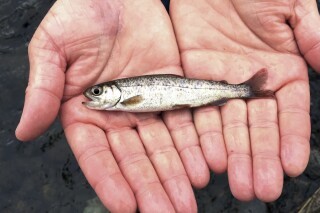
“The report states that 94% of fish stocks are not subject to overfishing, which is slightly better than a year ago. The U.S. was able to remove several important fish stocks from the overfishing list, NOAA said in a statement. […] The removal of species from the overfishing list shows the U.S. is making progress, said Rick Spinrad, NOAA’s administrator.”
5. Researchers Collaborate with the Shipping Industry to Cut Costs, Fuel Consumption and Greenhouse Gas Emissions in Shipping
“Through coordinated ship scheduling and an optimisation of ship operations and port services, the objective is to achieve a substantial increase in energy efficiency and a 10-20% reduction in fuel consumption, consequently resulting in lowered greenhouse gas emissions [and] leading to substantial economic benefits for shipping and environmental advantages for society[….]”
6. The city flower farm that is changing lives
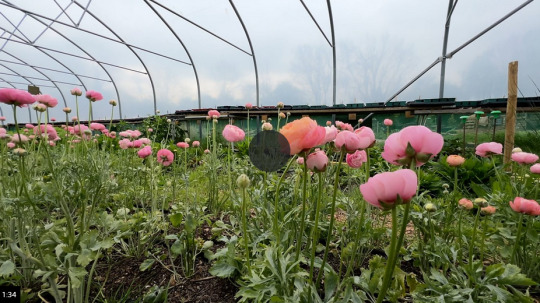
“Heart of BS13 Flowers in Hartcliffe is part of the wider Heart of BS13 charity which tackles food insecurity in south Bristol. Profits from the flower sales to run workshops, offer volunteer and trainee placements, and create education opportunities for people from Hartcliffe.”
7. Four falcon chicks hatch in Glasgow university tower
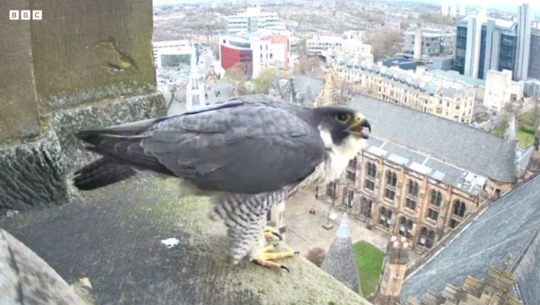
“Members of the [Glasgow Peregrine] project hope to […] fit [the chicks] with electronic tags that will enable monitoring of their movements. Mr Simpson added: "With the identification tags we can see where they have gone, how high they fly and other information that would be really useful." In recent years the group have held peregrine watches at the university, allowing people to see the birds in their nest.”
8. 'Banana pingers' are saving whales and dolphins around the world
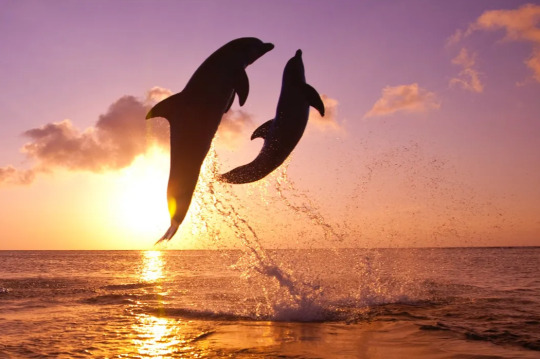
“[T]he Kibel brothers, Pete (a fisheries biologist) and Ben (an engineer) […] have been utilising light to protect turtles, sound to protect porpoises and electro pulses to protect sharks. [… Trials] showed reduced average catch rates of blue shark by 91%, and catch rates of pelagic stingray by 71% […as well as] a fall in the number of sea turtles being trapped by 42%.”
9. New vaccine effective against coronaviruses that haven't even emerged yet
“Researchers have developed a new vaccine technology that has been shown in mice to provide protection against a broad range of coronaviruses with potential for future disease outbreaks -- including ones we don't even know about. […] The new vaccine works by training the body's immune system to recognise specific regions of eight different coronaviruses, including SARS-CoV-1, SARS-CoV-2, and several that are currently circulating in bats and have potential to jump to humans and cause a pandemic.”
10. Grassland birds, Forest birds and Other Migratory Birds to Benefit from More Than $22 Million in Funding Throughout the Americas
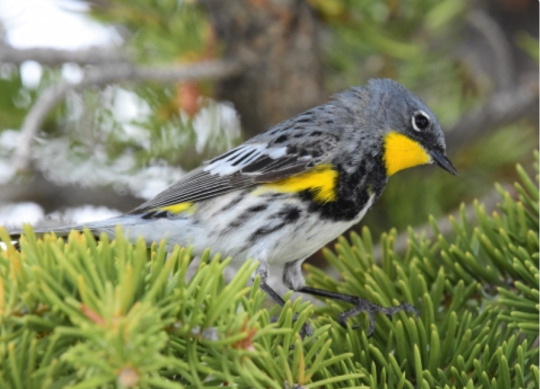
“This year, more than $4.87 million in federal funds will be matched by more than $17 million in partner contributions going to 30 collaborative conservation projects in 19 countries across the Americas. “These investments will [… protect] millions of acres of diverse habitats needed by grassland birds, forest birds and shorebirds for wintering, breeding and migration,” said Service Director Martha Williams.”
April 22-28 news here | (all credit for images and written material can be found at the source linked; I don’t claim credit for anything but curating.)
#good news#hopepunk#sorry its late i got distracted lol#biodiversity#conservation#seal#monk seal#hawaiʻi#oahu#first nations#fish#noaa#shipping#climate change#greenhouse gasses#ships#flowers#falcon#glasgow#university#peregrine falcon#birds#whale#dolphin#shark#turtles#vaccine#coronavirus#health#animals
18 notes
·
View notes
Text





Harry McNish – Scientist of the Day
Harry McNish, a Scottish ship's carpenter, was born Sept. 11, 1874, in Port Glasgow, Scotland.
read more...
#Harry McNish#McNeish#polar exploration#histsci#histSTM#20th century#history of science#Ashworth#Scientist of the Day
52 notes
·
View notes
Text
✨ 15 days of Princess Anne ✨
August is Princess Anne’s birth month and her 73rd birthday is on the 15th so until then we will look at her fascinating life, one photo for every year!
The 2020s

2020 1. 2. 3. A series of three photos, taken by John Swannell to celebrate Princess Anne’s 70th birthday!
4. Princess Anne photographed at Gatcombe Park with a pony for Australian Women’s Weekly ahead of her 70th birthday.

2021 1. Princess Anne and Sir Tim cheering on Scotland from home today as they played England for the Calcutta Cup on 6th February 2021
2. Princess Anne leading the funeral procession behind Prince Philip’s coffin at Windsor Castle on 17th April 2021
3. Princess Anne and Sir Tim Laurence marking Armed Forces Day at the National Memorial Arboretum in Alrewas on 26th June 2021
4. Queen Elizabeth II and Princess Anne visiting The Children’s Wood Project in Glasgow on 30th June 2021

2022 1. Princess Anne and her husband Sir Tim Laurence attend an event in Port Moresby, Papua New Guinea on 12th April 2022
2. Princess Anne and The Duchess of Cambridge arriving at the Royal College of Obstetricians and Gynaecologists and the Royal College of Midwives headquarters on 27th April 2022
3. Princess Anne curtsies to the coffin of her mother Queen Elizabeth II as it arrives at the Palace of Holyroodhouse in Edinburgh on 11th September 2022
4. Princess Anne and Sir Tim Laurence during their visit to the Falkland Islands in November 2022

2023 1. Princess Anne sending heart eyes to her husband as they visit New Zealand in February 2023.
2. Princess Anne arriving at Westminster Abbey for the coronation of King Charles III and Queen Camilla on 6th May 2023.
3. Princess Anne attending day one of Royal Ascot at Ascot Racecourse on 20th June 2023.
4. Princess Anne at the opening of the CHIO Aachen in Germany, on 27th June 2023.
#annie 🥺#she was so strong through ‘21 and ‘22 😭#my heart#the photo of her curtsying to her mothers coffins still breaks me now#but it’s so poignant that’s why I’ve included it#princess anne#princess royal#15 days of anne
59 notes
·
View notes
Text
A Deep Yearning for Connection & Finding Joy in Cobblestones
Ambiguity is hard when you ache for something - someone - to hold onto. I know he was a redhead. I know intuitively that he was deeply hurting. How could he not be?

View On WordPress
#alcoholism#ancestors#connection#genealogy#Greenock Blitz#Greenock Scotland#importante#Port Glasgow Road#Port Glasgow Scotland
0 notes
Text
Admired for its neoclassical elegance, the [...] silhouette of the early 1800s is linked to ideals of reforms [...]. For many these dresses embody the period depicted in Jane Austen’s novels, made familiar through cosy Sunday evening costume dramas. However, the sophisticated fashions worn by the Miss Emma Woodhouses of society were made possible only through the exploitation of people thousands of miles away. One of the most popular materials for these gowns was cotton, either a finely woven version known as muslin worn for evening wear or a slightly heavier weight cotton that was printed and used for day dresses. [...] When cotton became fashionable in the 1770s the best cotton muslins were imported as woven cloth from Bengal, which had been annexed on behalf of Britain by the East India Company in 1765. However, by the late 1700s vast amounts of raw cotton was imported from the southern states of America and the West Indies. Many of these cotton plantations, especially those in the Caribbean, were owned or managed by Scots, with the cotton sewn and harvested by enslaved men, woman and children brought over from Africa as part of the transatlantic slave trade, or their descendants. Cotton became a large part of the Scottish economy. The raw material was imported via Clyde ports from 1775 with 2,732,725 lbs imported in 1790 rising to 8,421,820 lbs in 1805. Cotton mills, which processed the raw cotton balls, were built creating a new industry. The first mill was built in Penicuik, Midlothian, but the majority were in Glasgow and surrounding counties, including New Lanark, where the damper climate aided production. Threads were spun and cloth woven, with further industries developing that embellished this naturally white fabric by embroidering, dying or printing on it. Some was sold and used here in Scotland, but the majority was exported with the result that cotton took over from wool as the leading British export good in 1803 – a position it held until 1938.
---
All text above by: Rebecca Quinton. “The Black History of White Cotton Dresses.” Legacies of Slavery in Glasgow Museums and Collections (a website maintained by curators and researchers of Glasgow Museums). 5 February 2019.
70 notes
·
View notes